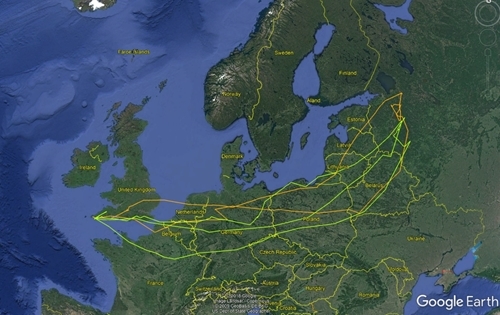A few weeks ago, we posted a blog about our annual field-trip to Cornwall where the Woodcock Watch team are running a long-term mark-and-recapture study. As well as ringing woodcock, a small sample were tagged with GPS loggers: small tracking devices that record their location but need to be recovered to access the data stored on board. We have been deploying these tags since 2016 and, this winter, have recovered seven of those deployed in previous years. This is the first in a series of blogs describing the results these tags have provided.

Tags 14591 (Green) and 14220 (Gold)
Green was tagged in 2017, Gold in 2018. Both woodcock returned to Western Russia. We know from our previous satellite-tagging that this is a very typical spring destination for woodcock wintering in southern Britain. The advantage of these GPS loggers, however, is that they record accurately and frequently during autumn as well as spring, providing information on the birds’ return journeys. It is interesting to see that there are some big differences between spring and autumn routes. Both birds travelled at more northerly latitudes during their autumn migration.
Green provided data for three migrations – two in spring and one in autumn. During the first spring migration, s/he crosses directly from Cornwall to France via the Cotentin peninsula, Normandy. In autumn, the bird crosses the channel at a narrower point, almost Calais to Dover, and repeated this the following spring.
The cause of these differences is currently unclear. Weather is likely to play some role; whether a deliberate detour to avoid poor weather or a navigational error caused by high-winds or poor visibility. But it may also be that routes evolve over the bird’s lifetime as it gains more experience? A larger dataset and some meteorological data will allow us to study these patterns.